The Nano Fibers Market is estimated to be valued at USD 2.8 billion in 2025 and is projected to reach USD 6.5 billion by 2035, registering a compound annual growth rate (CAGR) of 8.8% over the forecast period.
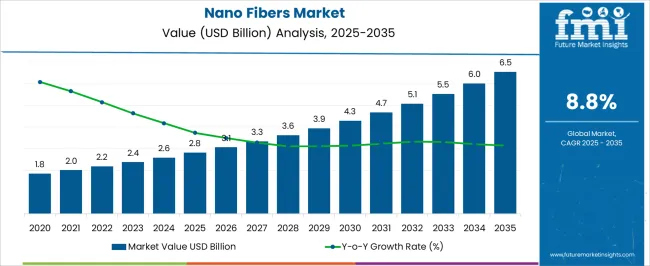
| Metric | Value |
|---|---|
| Nano Fibers Market Estimated Value in (2025 E) | USD 2.8 billion |
| Nano Fibers Market Forecast Value in (2035 F) | USD 6.5 billion |
| Forecast CAGR (2025 to 2035) | 8.8% |
The Nano Fibers market is experiencing strong growth, driven by increasing demand for advanced materials with high surface area, mechanical strength, and functional versatility across multiple industries. Adoption is being fueled by technological advancements in fabrication techniques, particularly electrospinning, which allows precise control over fiber diameter, porosity, and material composition. Rising applications in electronics, medical devices, filtration, energy storage, and composites are expanding the scope for nano fiber deployment.
Continuous research and development activities focused on enhancing fiber performance, scalability, and functionalization are supporting market growth. The market is further shaped by the increasing emphasis on lightweight, high-performance materials to improve efficiency and sustainability in end-use industries.
Investments by both public and private sectors in nanotechnology innovation and advanced material production are driving adoption, while regulatory support for high-performance materials in electronics, healthcare, and industrial applications is reinforcing growth prospects As industries continue to pursue performance optimization and material miniaturization, the Nano Fibers market is expected to maintain strong momentum over the coming decade.
The nano fibers market is segmented by manufacturing technique, product type, end use, and geographic regions. By manufacturing technique, nano fibers market is divided into Electro Spinning, Magneto Spinning, Phase Separation, Force Spinning, Melt-Blown Technology, and Rotary Jet Spinning. In terms of product type, nano fibers market is classified into Composite, Polymer, Cellulose, Carbon, Metallic, and Others. Based on end use, nano fibers market is segmented into Electronics, Mechanical, Chemical & Environment (MCE), Medical, Life Science, & Pharmaceutical (MLP), Energy, Chemistry, Instrumentation, and Automotive & Aerospace. Regionally, the nano fibers industry is classified into North America, Latin America, Western Europe, Eastern Europe, Balkan & Baltic Countries, Russia & Belarus, Central Asia, East Asia, South Asia & Pacific, and the Middle East & Africa.
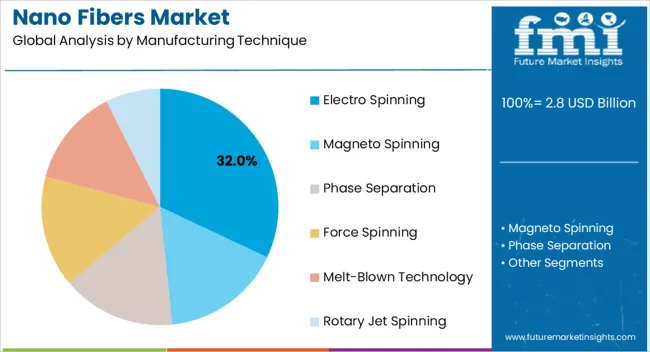
The electrospinning manufacturing technique segment is projected to hold 32.0% of the market revenue in 2025, establishing it as the leading production method. This technique is favored due to its ability to produce ultra-fine fibers with controlled morphology, high uniformity, and excellent mechanical and chemical properties. Electrospinning enables integration of diverse polymers, composites, and functional additives, which supports applications in filtration, electronics, tissue engineering, and energy storage.
Scalability, cost efficiency, and adaptability to different material systems have reinforced its adoption in industrial and research settings. The ability to create nanofibers with high surface area-to-volume ratios enhances performance in end-use applications such as sensors, batteries, and advanced composites.
Continuous improvements in electrospinning equipment and process optimization have strengthened reproducibility and reliability, ensuring wide-scale deployment As demand grows for high-performance materials with tailored properties, electrospinning is expected to maintain its leading position in the manufacturing segment, supported by technological innovation and application expansion.
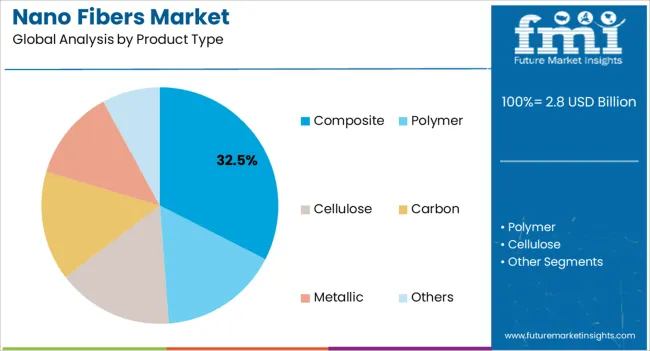
The composite product type segment is anticipated to account for 32.5% of the market revenue in 2025, making it the largest product category. Growth is being driven by the demand for lightweight, high-strength materials that combine the advantageous properties of different constituents, providing enhanced mechanical performance and functional versatility. Composite nano fibers are increasingly utilized in electronics, aerospace, automotive, and energy applications, where high performance and durability are critical.
The ability to customize fiber composition, structure, and surface properties allows manufacturers to meet specific application requirements while improving product performance. Continuous development in hybrid and functionalized composites has expanded their applicability and reliability.
Adoption is further supported by the increasing focus on sustainability and energy-efficient materials, as composites often reduce material consumption and improve structural efficiency As industries prioritize performance optimization, durability, and multifunctionality, composite nano fibers are expected to maintain their market leadership, reinforced by technological advancements and growing demand across high-performance applications.
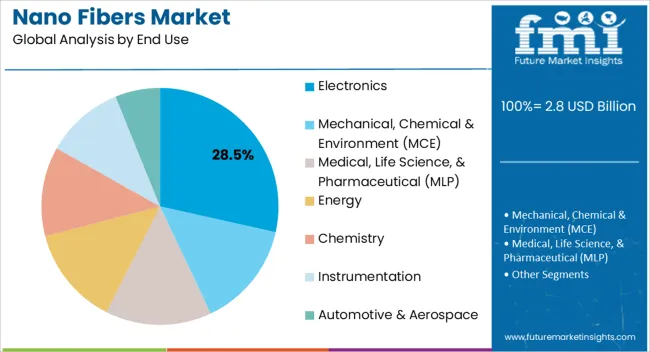
The electronics end-use industry segment is expected to hold 28.5% of the market revenue in 2025, positioning it as a leading application sector. Growth is being driven by the demand for nano fibers in energy storage devices, sensors, flexible electronics, and conductive materials that enhance performance, efficiency, and miniaturization. The high surface area, porosity, and mechanical strength of nano fibers support improved charge storage, conductivity, and sensitivity in electronic components.
Increasing adoption of smart devices, wearable electronics, and next-generation battery technologies is further reinforcing demand. Integration of composite and functionalized fibers allows electronic manufacturers to develop lightweight, high-performance, and durable components that meet evolving technological requirements.
Ongoing R&D and process optimization have enhanced reliability, consistency, and scalability, enabling wider deployment As electronic devices continue to demand higher efficiency, precision, and multifunctionality, the electronics end-use sector is expected to remain a key driver of nano fiber market growth, supported by innovations in materials engineering and advanced manufacturing techniques.
Nano fibers are extremely popular in many industries today for their enhanced chemical and mechanical properties such as light weight, durability, etc. and are also found to have been highly compatible with various devices without interfering with the performance of end-products.
The growth of the nano fibers market can be observed by the fact that over the last couple of years, penetration of nano fibers in the medical, pharmaceutical, mechanical, chemical, and environment sectors has increased to a great extent and is further expected to be growing over the coming years.
The production of a number of products from composite nano fibers is one of the most important innovations of this century. Nano fibers offer solutions for several fundamental problems in the progression of human society, including portable sources of energy, cleaning and preserving drinking water, battery aided innovative energy storage, etc.
Nano fibers are also used extensively in air filtration due to their efficiency in removing submicron particles, including viruses and bacteria.
The ability of nano fibers to change the properties of a wide spectrum of materials has led to an extensively growing market for them, especially in the commercial sector. The nano fibers market is expected to have better opportunities in several value added applications such as garments, personal care, insulation, filtration, energy storage, etc. among others, and their market is expected to witness a high growth rate over the coming years 2025–2035.
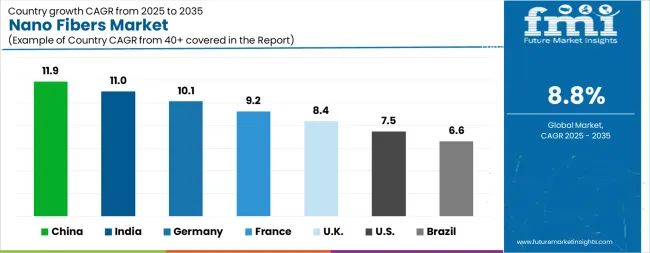
| Country | CAGR |
|---|---|
| China | 11.9% |
| India | 11.0% |
| Germany | 10.1% |
| France | 9.2% |
| UK | 8.4% |
| USA | 7.5% |
| Brazil | 6.6% |
The Nano Fibers Market is expected to register a CAGR of 8.8% during the forecast period, exhibiting varied country level momentum. China leads with the highest CAGR of 11.9%, followed by India at 11.0%. Developed markets such as Germany, France, and the UK continue to expand steadily, while the USA is likely to grow at consistent rates. Brazil posts the lowest CAGR at 6.6%, yet still underscores a broadly positive trajectory for the global Nano Fibers Market. In 2024, Germany held a dominant revenue in the Western Europe market and is expected to grow with a CAGR of 10.1%. The USA Nano Fibers Market is estimated to be valued at USD 987.7 million in 2025 and is anticipated to reach a valuation of USD 2.0 billion by 2035. Sales are projected to rise at a CAGR of 7.5% over the forecast period between 2025 and 2035. While Japan and South Korea markets are estimated to be valued at USD 150.8 million and USD 81.4 million respectively in 2025.
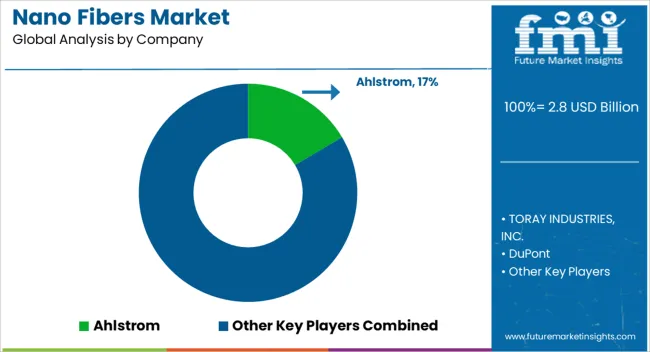
| Item | Value |
|---|---|
| Quantitative Units | USD 2.8 Billion |
| Manufacturing Technique | Electro Spinning, Magneto Spinning, Phase Separation, Force Spinning, Melt-Blown Technology, and Rotary Jet Spinning |
| Product Type | Composite, Polymer, Cellulose, Carbon, Metallic, and Others |
| End Use | Electronics, Mechanical, Chemical & Environment (MCE), Medical, Life Science, & Pharmaceutical (MLP), Energy, Chemistry, Instrumentation, and Automotive & Aerospace |
| Regions Covered | North America, Europe, Asia-Pacific, Latin America, Middle East & Africa |
| Country Covered | United States, Canada, Germany, France, United Kingdom, China, Japan, India, Brazil, South Africa |
| Key Companies Profiled | Ahlstrom, TORAY INDUSTRIES, INC., DuPont, Asahi Kasei Corporation, Donaldson Company, Inc., Elmarco Ltd., Johns Manville. A Berkshire Hathaway Company, and Jiangxi Xian Cai Nanofibers Technology Co., Ltd. |
The global nano fibers market is estimated to be valued at USD 2.8 billion in 2025.
The market size for the nano fibers market is projected to reach USD 6.5 billion by 2035.
The nano fibers market is expected to grow at a 8.8% CAGR between 2025 and 2035.
The key product types in nano fibers market are electro spinning, magneto spinning, phase separation, force spinning, melt-blown technology and rotary jet spinning.
In terms of product type, composite segment to command 32.5% share in the nano fibers market in 2025.






Our Research Products

The "Full Research Suite" delivers actionable market intel, deep dives on markets or technologies, so clients act faster, cut risk, and unlock growth.

The Leaderboard benchmarks and ranks top vendors, classifying them as Established Leaders, Leading Challengers, or Disruptors & Challengers.

Locates where complements amplify value and substitutes erode it, forecasting net impact by horizon

We deliver granular, decision-grade intel: market sizing, 5-year forecasts, pricing, adoption, usage, revenue, and operational KPIs—plus competitor tracking, regulation, and value chains—across 60 countries broadly.

Spot the shifts before they hit your P&L. We track inflection points, adoption curves, pricing moves, and ecosystem plays to show where demand is heading, why it is changing, and what to do next across high-growth markets and disruptive tech

Real-time reads of user behavior. We track shifting priorities, perceptions of today’s and next-gen services, and provider experience, then pace how fast tech moves from trial to adoption, blending buyer, consumer, and channel inputs with social signals (#WhySwitch, #UX).

Partner with our analyst team to build a custom report designed around your business priorities. From analysing market trends to assessing competitors or crafting bespoke datasets, we tailor insights to your needs.
Supplier Intelligence
Discovery & Profiling
Capacity & Footprint
Performance & Risk
Compliance & Governance
Commercial Readiness
Who Supplies Whom
Scorecards & Shortlists
Playbooks & Docs
Category Intelligence
Definition & Scope
Demand & Use Cases
Cost Drivers
Market Structure
Supply Chain Map
Trade & Policy
Operating Norms
Deliverables
Buyer Intelligence
Account Basics
Spend & Scope
Procurement Model
Vendor Requirements
Terms & Policies
Entry Strategy
Pain Points & Triggers
Outputs
Pricing Analysis
Benchmarks
Trends
Should-Cost
Indexation
Landed Cost
Commercial Terms
Deliverables
Brand Analysis
Positioning & Value Prop
Share & Presence
Customer Evidence
Go-to-Market
Digital & Reputation
Compliance & Trust
KPIs & Gaps
Outputs
Full Research Suite comprises of:
Market outlook & trends analysis
Interviews & case studies
Strategic recommendations
Vendor profiles & capabilities analysis
5-year forecasts
8 regions and 60+ country-level data splits
Market segment data splits
12 months of continuous data updates
DELIVERED AS:
PDF EXCEL ONLINE
Cellulose Nanocrystals and Nanofibers Market Size and Share Forecast Outlook 2025 to 2035
Nanoscale Zero-Valent Iron Market Size and Share Forecast Outlook 2025 to 2035
Nanoscale Sand Mill Market Size and Share Forecast Outlook 2025 to 2035
Nano Coating Market Size and Share Forecast Outlook 2025 to 2035
Nanotechnology Photocatalysis Surface Coating Industry Analysis in AMEA Size and Share Forecast Outlook 2025 to 2035
Nanosensors Market Size and Share Forecast Outlook 2025 to 2035
Nano Precipitated Calcium Carbonate Market Size and Share Forecast Outlook 2025 to 2035
Nanocatalysts Market Size and Share Forecast Outlook 2025 to 2035
Nano Suspension Market Analysis - Size, Share, and Forecast Outlook 2025 to 2035
Nanotechnology Packaging Market Size and Share Forecast Outlook 2025 to 2035
Nanocellulose Coating Market Analysis - Size and Share Forecast Outlook 2025 to 2035
Nanocrystalline cellulose Market Size and Share Forecast Outlook 2025 to 2035
Nanocellulose Barrier Coating Market Analysis - Size and Share Forecast Outlook 2025 to 2035
Nano Zinc Oxide Market Size and Share Forecast Outlook 2025 to 2035
Nano Composite Zirconia Market Size and Share Forecast Outlook 2025 to 2035
Nano Dentistry Market Size and Share Forecast Outlook 2025 to 2035
Nanomaterial Supercapacitors Market Size and Share Forecast Outlook 2025 to 2035
Nano Fertilizers Market Size and Share Forecast Outlook 2025 to 2035
Nanosilver Market Size and Share Forecast Outlook 2025 to 2035
Nanographic Printing Market Size and Share Forecast Outlook 2025 to 2035

Thank you!
You will receive an email from our Business Development Manager. Please be sure to check your SPAM/JUNK folder too.
Chat With
MaRIA